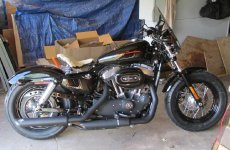That is correct. Stability factor generally goes up as the bullet goes downrange.
Use this calculator and you can see the increase in gyroscopic stability factor with range in the last column of the table at the bottom of the result page.
We start with the assumption is that the bullet is fired with enough spin to be stable to begin with. Any initial yaw not so great as to cause direct tumbling will be about 80-90% damped out after a couple of hundred yards (see Litz's plots of this in his Applied Ballistics for Long Range Shooting, page 156 of the 1st Ed.). Interestingly, that distance does not change with spin rate because while it is true faster spin reduces the number of cycles of coning needed to close in on the final stable orientation of the bullet (assuming constant wind conditions), the greater gyroscopic stiffness of the faster spin makes each one of those cycles slower. The two effects cancel each other out.
As to center of gravity, that determines the location of the transverse moment of inertia, and the axis location of the axial moment of inertia, both of which are critical to calculating minimum stable spin rate at any particular velocity. You can determine both by using a vertical torsion pendulum and a stopwatch. I won't go through the procedure here because you can look at several methods published by physics teachers online. A critical point is that if the CG is not exactly centered in the bullet axis, faster spin of the bullet will introduce helical wobble. Additionally, lateral drift after exiting the muzzle that is due to spinning an off-center CG in the bore will also increase with spin rate. So, when people say, "over stabilized", they are really just saying that it is spinning faster than is strictly necessary for best accuracy, and therefore increasing the chances that a small manufacturing error in the bullet CG location, or an off-center CG caused by a few thousandths of bullet tilt in the barrel, will open the group more than you have if you stuck to a stability factor of about 1.5.
The shockwave formation does, of course, affect drag by creating the sound barrier effect, but that is just a rise in drag that exceeds what Newtons formula predicts. It is not more than you have at still higher velocities. So, again, if you are spinning fast enough to be stable at the muzzle, you are more than fast enough to be stable at the lower velocities that drag produces.

